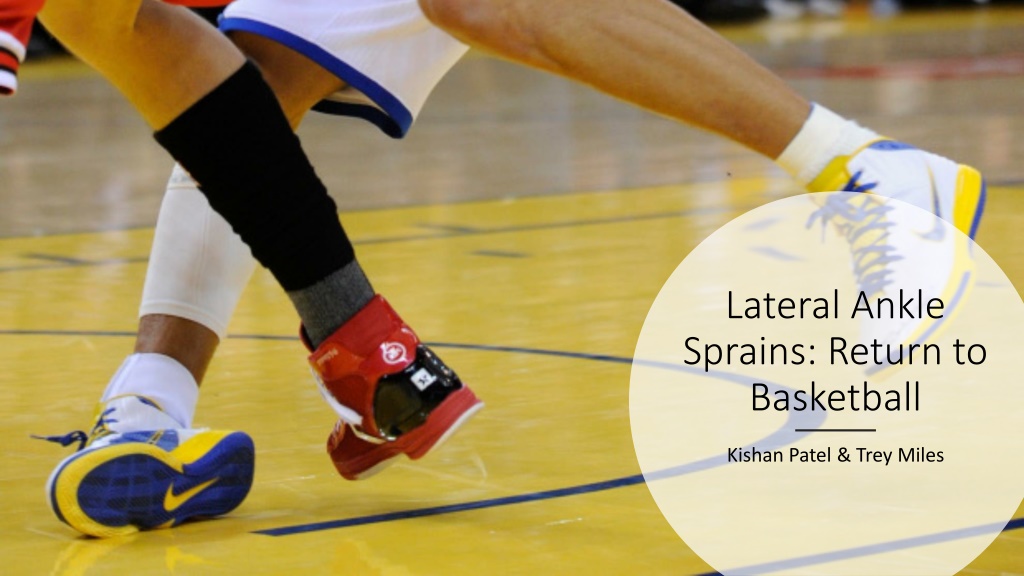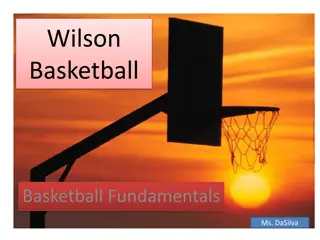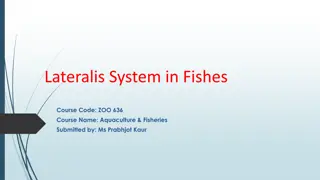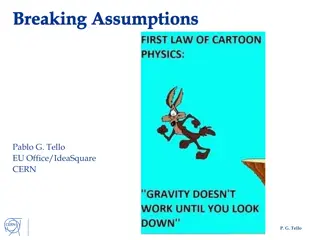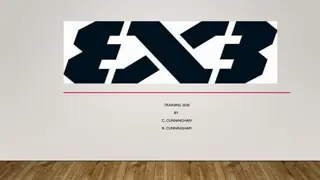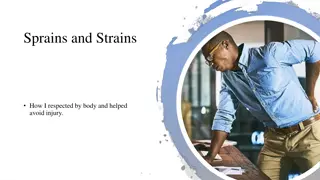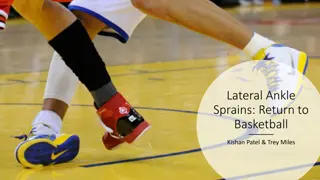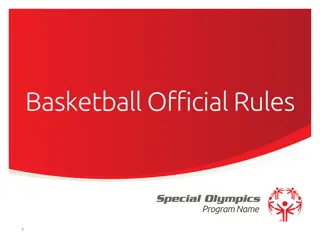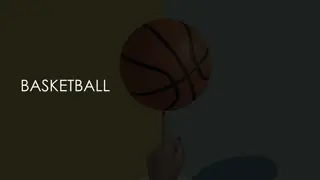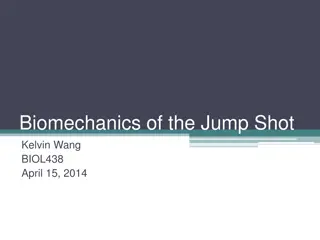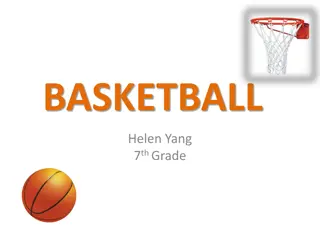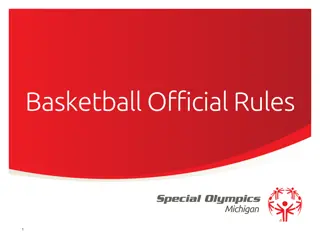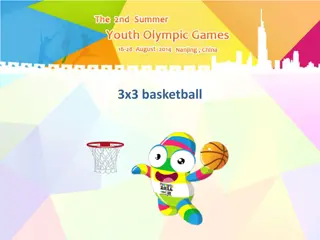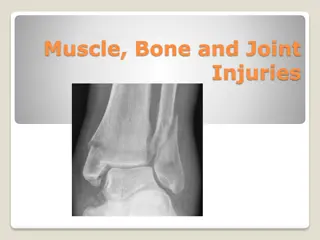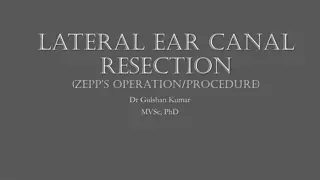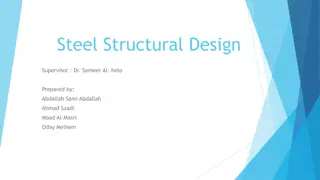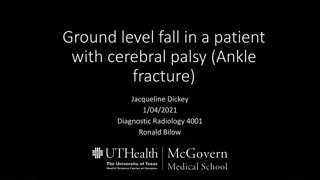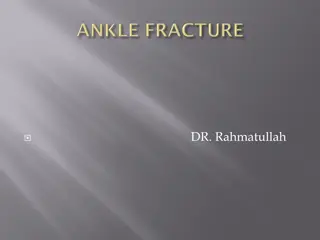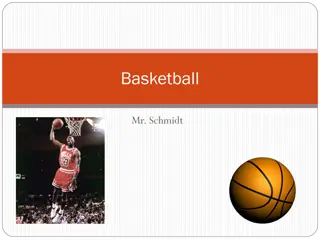Lateral Ankle Sprains Return to Basketball Presentation
This presentation focuses on the return-to-sport guidelines for basketball players after a lateral ankle sprain. It covers the prevalence of ankle sprains in basketball, the PAASS framework for assessment, specific tests for return-to-sport decisions, common impairments, athlete perception, sensorimotor control, and sports performance considerations. The content emphasizes the importance of recognizing the need for guidelines, understanding the PAASS framework, and applying specific tests for safe return to basketball post-injury.
Download Presentation

Please find below an Image/Link to download the presentation.
The content on the website is provided AS IS for your information and personal use only. It may not be sold, licensed, or shared on other websites without obtaining consent from the author. Download presentation by click this link. If you encounter any issues during the download, it is possible that the publisher has removed the file from their server.
E N D
Presentation Transcript
Lateral Ankle Sprains: Return to Basketball Kishan Patel & Trey Miles
Objectives At the conclusion of this presentation, participants will be able to: 1. Recognize the need for lateral ankle sprain RTS guidelines 2. Understand the PAASS framework and ideas for how to utilize it 3. Apply specific tests and measures for RTS in basketball players with LAS
Mechanism1,2 Excess inversion = ligamentous shear
Background1,23 Ankle sprains affect 26% of professional basketball players each season, with 80% of these involving injury to the lateral low ankle.1 Lateral ankle sprains are the most common reported injury among collegiate student-athletes.23 Sports with the highest percentage of injury and recurrence are Men's Basketball and Women's Basketball.23
Extremely Common, But No Guidelines4,5.6 ~95% ~75% ~70% High school athletes RTS within 10 days High school athletes RTS within 3 days Develop CAI after an acute LAS
PAASS Over That Framework7 Pain: assessed during participation in sport over the past 24 hours
Pain22 Pain Self-Efficacy Questionnaire Numeric Pain Rating Scale
Ankle Impairments8,14,15,16,17,19 ROM Weight-Bearing Lunge Test Muscle Performance
Athlete Perception8,20,21 Fear Avoidance Beliefs Questionnaire (FABQ) 11 Item Tampa Scale of Kinesiophobia
Sensorimotor Control8,10,12,13 Proprioception Single-Leg Balance on Firm Surface Dynamic Postural Control/Balance SEBT Demi-Pointe
Sports/Functional Performance7,14,18,24,25,26,27 Jumping/Hopping Drop-Vertical Jump Single-Leg Drop Landing Crossover Hop Test Agility T-Test Illinois Agility Test
Evidence Gap9 Several studies have reported findings that identify no significant relationships between specific clinical tests and return to function.
References 1. Herzog MM, Mack CD, Dreyer NA, et al. Ankle Sprains in the National Basketball Association, 2013-2014 Through 2016-2017. Am J Sports Med. 2019;47(11):2651-2658. doi:10.1177/0363546519864678 2. Moore ML, Haglin JM, Hassebrock JD, Anastasi MB, Chhabra A. Management of ankle injuries in professional basketball players: Prevalence and rehabilitation. Orthop Rev (Pavia). 2021;13(1):9108. doi:10.4081/or.2021.9108 3. Wolfe MW, Uhl TL, Mattacola CG, McCluskey LC. Management of ankle sprains. Am Fam Physician. 2001;63(1):93-104. 4. Tassignon B, Verschueren J, Delahunt E, et al. Criteria-Based Return to Sport Decision-Making Following Lateral Ankle Sprain Injury: a Systematic Review and Narrative Synthesis. Sports Med. 2019;49(4):601-619. doi:10.1007/s40279-019-01071-3 5. Medina McKeon JM, Bush HM, Reed A, Whittington A, Uhl TL, McKeon PO. Return-to-play probabilities following new versus recurrent ankle sprains in high school athletes. J Sci Med Sport. 2014;17(1):23-28. doi:10.1016/j.jsams.2013.04.006 6. Gribble PA, Bleakley CM, Caulfield BM, et al. Evidence review for the 2016 International Ankle Consortium consensus statement on the prevalence, impact and long-term consequences of lateral ankle sprains. Br J Sports Med. 2016;50(24):1496-1505. doi:10.1136/bjsports-2016-096189 7. Smith MD, Vicenzino B, Bahr R, et al. Return to sport decisions after an acute lateral ankle sprain injury: introducing the PAASS framework-an international multidisciplinary consensus. Br J Sports Med. 2021;55(22):1270-1276. doi:10.1136/bjsports-2021-104087 8. Martin RL, Davenport TE, Fraser JJ, et al. Ankle stability and movement coordination impairments: lateral ankle ligament sprains revision 2021. J Orthop Sports Phys Ther. 2021;51(4):CPG1-CPG80. doi:10.2519/jospt.2021.0302 9. Cross KM, Worrell TW, Leslie JE, Van Veld KR. The relationship between self-reported and clinical measures and the number of days to return to sport following acute lateral ankle sprains. J Orthop Sports Phys Ther. 2002;32(1):16-23. doi:10.2519/jospt.2002.32.1.16 10. Hiller CE, Refshauge KM, Herbert RD, Kilbreath SL. Balance and recovery from a perturbation are impaired in people with functional ankle instability. Clin J Sport Med. 2007;17(4):269-275. doi:10.1097/JSM.0b013e3180f60b12
References (Cont.) 11. Chaput M, Onate JA, Simon JE, et al. Visual-Cognition Associated with Knee Proprioception, Time to Stability, and Sensory Integration Neural Activity after ACL Reconstruction. J Orthop Res. Published online February 23, 2021. doi:10.1002/jor.25014 12. Chaput, M. New Frontiers in Rehabilitation from ACL Reconstruction: Simplifying Explanations for a Complex Rehabilitation. Presented at UNC Division of Physical Therapy. January 26, 2023. Chapel Hill, NC. 13. Attenborough AS, Sinclair PJ, Sharp T, et al. The identification of risk factors for ankle sprains sustained during netball participation. Phys Ther Sport. 2017;23:31-36. doi:10.1016/j.ptsp.2016.06.009 14. Herb CC, Grossman K, Feger MA, Donovan L, Hertel J. Lower Extremity Biomechanics During a Drop-Vertical Jump in Participants With or Without Chronic Ankle Instability. J Athl Train. 2018;53(4):364-371. doi:10.4085/1062-6050-481-15 15. Adill n C, Gallegos M, Trevi o S, Salvat I. Ankle Joint Dorsiflexion Reference Values in Non-Injured Youth Federated Basketball Players: A Cross- Sectional Study. Int J Environ Res Public Health. 2022;19(18). doi:10.3390/ijerph191811740 16. Halabchi F, Hassabi M. Acute ankle sprain in athletes: Clinical aspects and algorithmic approach. World J Orthop. 2020;11(12):534-558. doi:10.5312/wjo.v11.i12.534 17. Khalaj N, Vicenzino B, Smith MD. Hip and knee muscle torque and its relationship with dynamic balance in chronic ankle instability, copers and controls. J Sci Med Sport. Published online February 9, 2021. doi:10.1016/j.jsams.2021.01.009 18. Sheppard JM, Young WB. Agility literature review: classifications, training and testing. J Sports Sci. 2006;24(9):919-932. doi:10.1080/02640410500457109 19. Kobayashi T, Tanaka M, Shida M. Intrinsic Risk Factors of Lateral Ankle Sprain: A Systematic Review and Meta-analysis. Sports Health. 2016;8(2):190- 193. doi:10.1177/1941738115623775 20. Corbett RO, Keith TR, Hertel J. Patient-Reported Outcomes and Perceived Confidence Measures in Athletes With a History of Ankle Sprain. J Sport Rehabil. 2020;29(6):795-800. doi:10.1123/jsr.2018-0310
References (Cont.) 21. Larmer PJ, McNair PJ, Smythe L, Williams M. Ankle sprains: patient perceptions of function and performance of physical tasks. A mixed methods approach. Disabil Rehabil. 2011;33(23-24):2299-2304. doi:10.3109/09638288.2011.568668 22. Briet JP, Houwert RM, Hageman MGJS, Hietbrink F, Ring DC, Verleisdonk EJJM. Factors associated with pain intensity and physical limitations after lateral ankle sprains. Injury. 2016;47(11):2565-2569. doi:10.1016/j.injury.2016.09.016 23. Roos KG, Kerr ZY, Mauntel TC, Djoko A, Dompier TP, Wikstrom EA. The epidemiology of lateral ligament complex ankle sprains in national collegiate athletic association sports. Am J Sports Med. 2017;45(1):201-209. doi:10.1177/0363546516660980 24. Doherty C, Bleakley C, Hertel J, Caulfield B, Ryan J, Delahunt E. Single-leg drop landing movement strategies in participants with chronic ankle instability compared with lateral ankle sprain copers . Knee Surg Sports Traumatol Arthrosc. 2016;24(4):1049-1059. doi:10.1007/s00167-015-3852-9 25. Doherty C, Bleakley C, Hertel J, Caulfield B, Ryan J, Delahunt E. Single-leg drop landing movement strategies 6 months following first-time acute lateral ankle sprain injury. Scand J Med Sci Sports. 2015;25(6):806-817. doi:10.1111/sms.12390 26. S Jamsandekar M, Patel VD, J Prabhakar A, Eapen C, Keogh JWL. Ability of functional performance assessments to discriminate athletes with and without chronic ankle instability : a case-control study. PeerJ. 2022;10:e13390. doi:10.7717/peerj.13390 27. Kotsifaki A, Korakakis V, Graham-Smith P, Sideris V, Whiteley R. Vertical and horizontal hop performance: contributions of the hip, knee, and ankle. Sports Health. 2021;13(2):128-135. doi:10.1177/1941738120976363
Additional Resources 1. OCS Field Guide: A PT Podcast. Lateral Ankle Sprains CPG: Course, Diagnosis, and Exam | Listen Notes. January 10, 2023. https://www.listennotes.com/podcasts/ocs-field-guide-a/lateral- ankle-sprains-cpg-3kn7601uWRh/. Accessed February 24, 2023. 2. Emery CA, Owoeye OBA, R is nen AM, et al. The SHRed Injuries Basketball Neuromuscular Training Warm-up Program Reduces Ankle and Knee Injury Rates by 36% in Youth Basketball. J Orthop Sports Phys Ther. 2022;52(1):40-48. doi:10.2519/jospt.2022.10959
